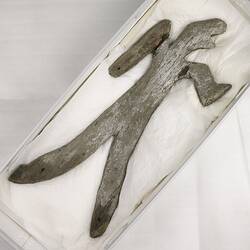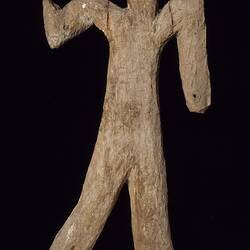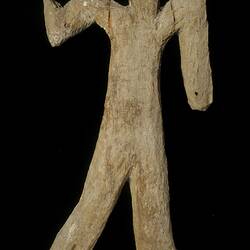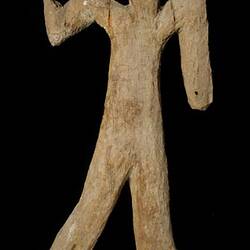Summary
This is one of a very small number of sculptural forms from Aboriginal Victoria surviving from the nineteenth century, and at least one of Bullock Jack's figures are thought to be in the museum in Berlin, Germany. An effigy of an emu collected by John Hunter Kerr from the Loddon River area in 1854 is the only other known sculptural form and it is to be found in the collections of the British Museum.
Physical Description
A human figure made from a single piece of wood. White and brown ochre. One arm points upwards and the other downwards.
Significance
This is a rare example of sculpture from Aboriginal Victoria and it was made by Bullock Jack at Ramahyuck Mission Station in Gippsland in the late nineteenth century. The effigy has remnants of white ochre on the surface and stands almost a metre tall. An historical report suggests that his figures were modelled on those made for sacred ceremonies. The museum has a photograph taken at the mission showing a similar figure with both hands upwards hanging from the side of his cottage. Few details are known about Bullock Jack, however an anonymous article in the ARGUS newspaper in January 1886 describes him as a 'harmless mad inventor', who had erected poles around a paddock imitating telegraph poles. He is described as proudly wearing an old uniform and cap 'adorned with tarnished silver lace' and a regular church goer. This effigy was donated to the museum by the granddaughter of the missionary who established Ramahyuck mission, the Reverend Hagenauer.
More Information
-
Object/Medium
Figure
-
Maker
-
Locality
-
Date Produced
-
Date Collected
-
Object Measurements
910 mm (Length), 390 mm (Width), 100 mm (Height)
-
Keywords
-
References
[Book] Museum Victoria. 2004. Treasures of the Museum. Victoria, Australia. 206.
-
Type of item
-
Discipline
-
Category
-
Collecting Areas




